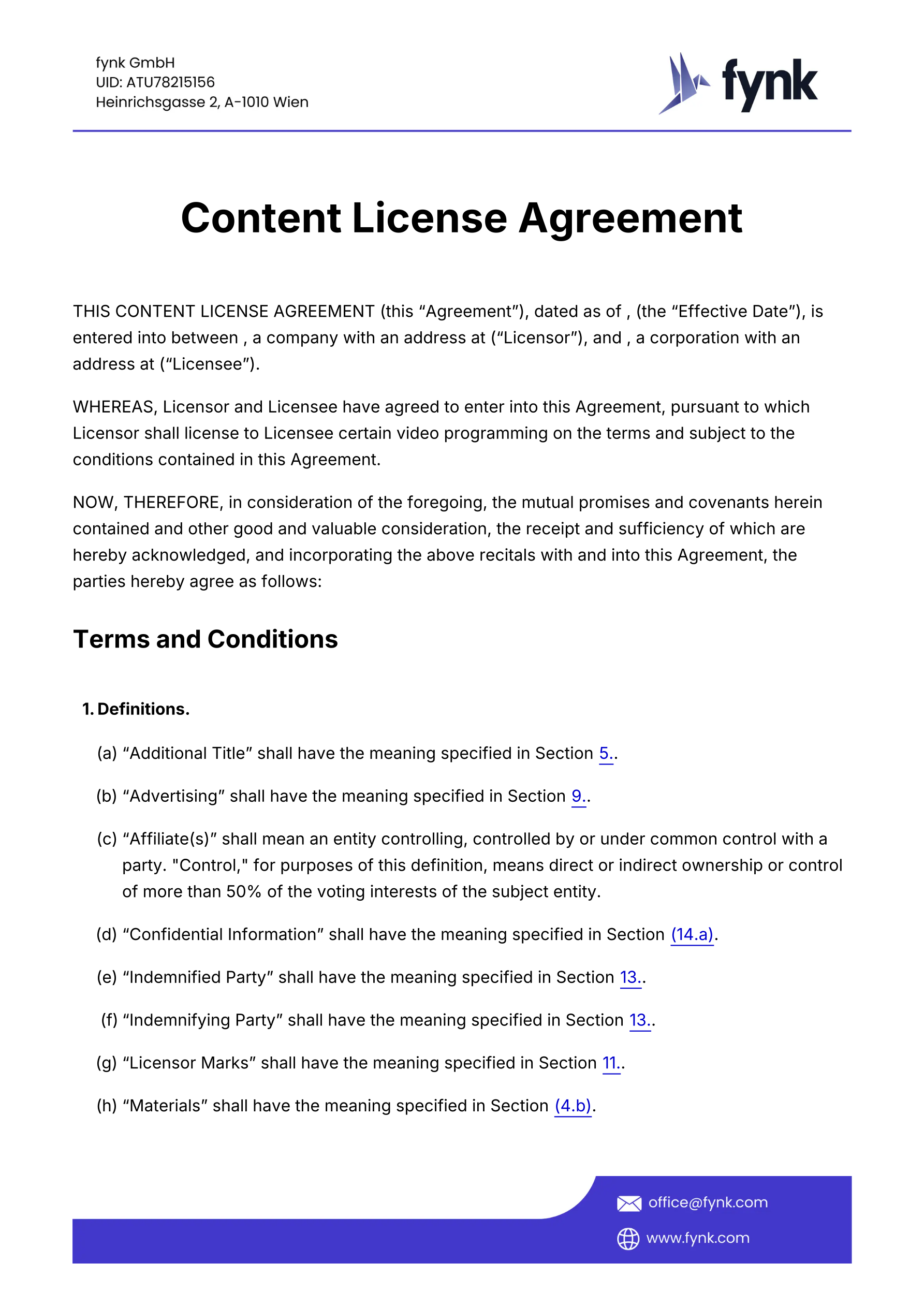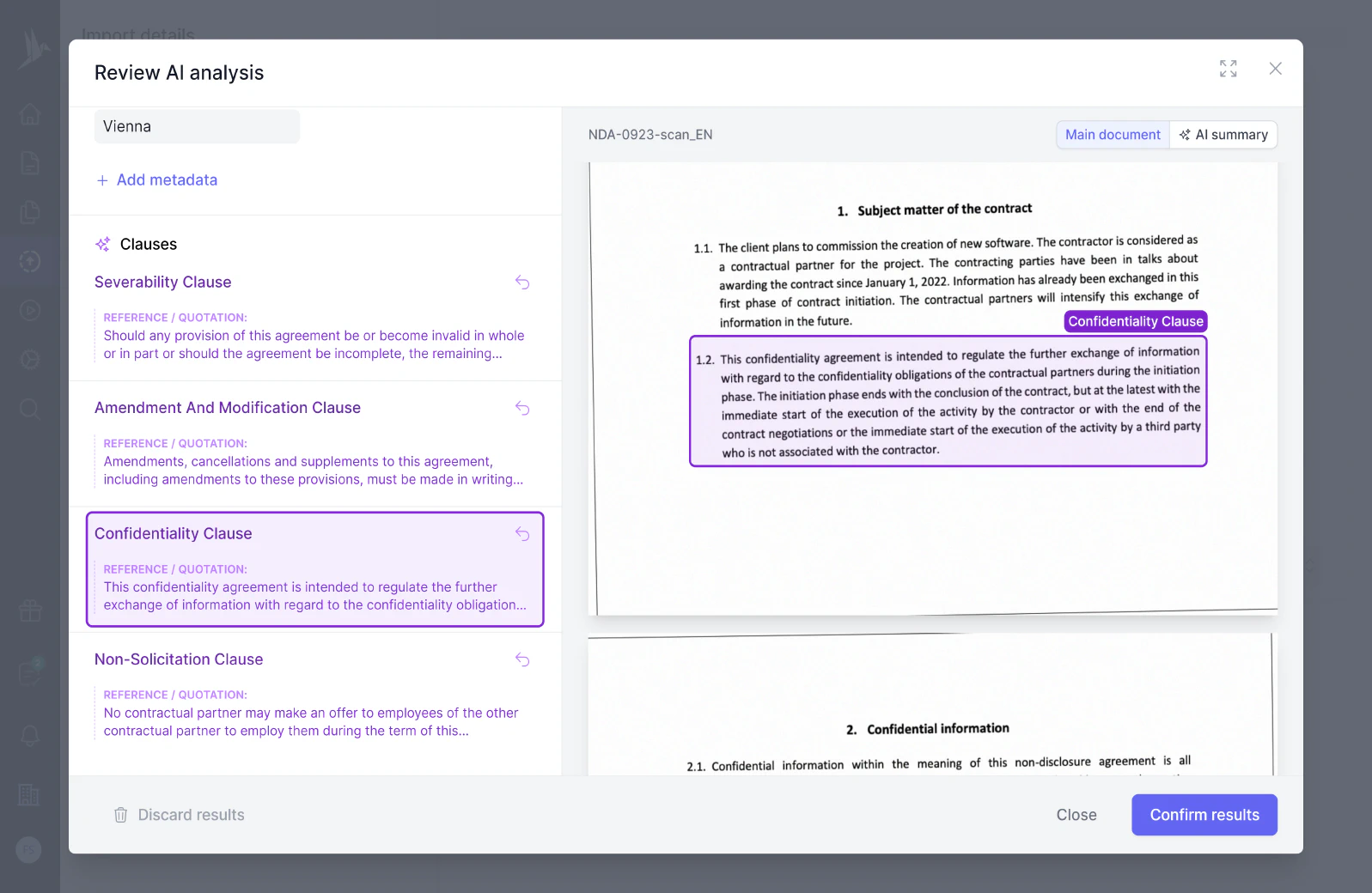
Content License Agreement Template
A content license agreement template that governs the licensing, distribution, monetization, and marketing of audiovisual programs across streaming platforms.
A license grant clause in a contract specifies the permissions and limitations under which the licensee can use the licensor's property, such as intellectual property or technology. It defines the scope, duration, territory, and conditions of the granted rights, thereby outlining the legal framework for usage and ensuring protection for the licensor's assets.
“Non-Exclusive License Grant. Merck hereby grants to Licensee a non-exclusive license in the Territory in the Field and for Diagnostic Purposes to any patent applications or patents owned or controlled by Merck that result from the exercise of its Research License under Section 2.01(c), but only to the extent said patent applications or patents (i) have claims specifically and solely covering Licensed Compound and/or the Manufacture and/or use thereof and (ii) are reasonably necessary by Licensee for the Development or Commercialization of Licensed Compound as contemplated in the Development Plan, said non-exclusive license to Develop, Manufacture, have Manufactured, use, import, export and Commercialize Licensed Compound in the Field and for Diagnostic Purposes in the Territory during the Term in accordance with the Development Plan.”
Licensor Capsid Patent Rights. At any time during the Term, Licensor may provide written notice to Licensee that a Third Party is interested in obtaining an exclusive license grant under the Licensor Capsid Patent Rights for an indication that is subject to the non-exclusive license grant set forth in Section 3.1.6(b). Upon receipt of written notice, Licensee may, in its sole discretion, provide to Licensor written notice to exclude such indication from the non-exclusive license grant set forth in Section 3.1.6(b). Upon receipt of such written notice, the Parties shall negotiate in good faith an amendment to the Agreement. For clarity, Licensee is not obligated to exclude such indication or enter into an amendment to exclude such indication.
License Grant from Biohaven. As of the Effective Date, subject to the terms and conditions of this Agreement and the Biohaven Collaboration Agreement, Biohaven hereby grants to Pfizer a non-transferable (except as set forth in Section 5.5 (Assignment)), exclusive (even as to Biohaven and its Affiliates) sublicense under the (a) BMS Patent Rights other than the BioShin BMS Patent Rights (the “Biohaven BMS Patent Rights”) and (b) the BMS Know-How other than the BioShin BMS Know-How (the “Biohaven BMS Know-How”), in each case, including the assigned rights granted pursuant to the Biohaven Ireland Assignment, with the right to grant further sublicenses solely in accordance with Section 2.3 (Sublicenses), to Commercialize the Licensed Compounds and Licensed Products in the Field in the Territory.
LICENSE GRANTS AND OWNERSHIP 1 Grant. Subject to the terms and conditions of this Agreement, RDT hereby grants to Licensee in the Initial Territory, and in each Additional Territory, a non-sublicensable, personal, non-transferable, revocable, Gold Vendor Status license for the Term within the Territory to: 1.1 use the RDT IP solely in order to produce Product at the Licensed Premises, either alone or in association with Licensee trade-marks and brands; 1.2 use the brand name QuickStrip™ solely in relation to the Product in its sales, marketing, packaging, and promotional materials of the Product where permitted by Applicable Law(s); 1.3 use the Equipment at the Licensee Premises solely in order to produce the Product; 1.4 brand products with the Trade-marks, use the Trade-marks specified in Schedule "C" in and for the Territory for which they are designated, and on the condition that the relevant country or State is listed as an Initial Territory or Additional Territory for the Licensee, solely in order to promote, distribute and sell the Product(s); and 1.5 market, distribute, promote, offer for sale, and sell, the Product in the Territory as set out in Schedule "D"; all in accordance with Applicable Laws in consideration for the Service Fees and all terms and conditions set forth in this Agreement (the "License Grant"). Licensee's use of any of the Trade-marks licensed under this Agreement shall be subject to RDT's trademark use guidelines (including control over quality of wares/services) and all goodwill shall ensure to the benefit of RDT.
CONSIDERATION FOR LICENSE GRANT; ADEQUACY OF CONSIDERATION. 1 Term Payment. Subject to the terms and conditions of this Agreement, as consideration for Licensor providing Licensee with the License Grant for the Term, Licensee shall pay Licensor a fee (the “License Fee”) consisting of: a) A royalty in the amount of five percent (5%) (the “Royalty”) of the gross revenue received from the sublicense of the Software and any revenues generated from the use of the Sublicensed Materials for the term of this Agreement, less (i) applicable sales and use taxes (but in no event to include income or franchise taxes), (ii) any export duties, shipping, freight and handling charges paid by Licensee and reimbursed by customers, (iii) any trade and quantity discounts actually taken, and (iv) any credits for sales previously recorded but cancelled or refunded to a customer (“Net Revenues”). Licensee shall pay Licensor the Royalty due on a quarterly basis for each fiscal quarter during the term of this Agreement commencing three (3) months after the Licensee releases a “go live” version of the Software that utilizes the Sublicensed Material (the “Go Live Date”). The quarterly Royalty payment will be due on or before the thirtieth (30th) day after the last day of the fiscal quarter for which the Royalty payment is calculated;
License Grant; Reservation of Rights; Right to Conduct 2008 Trial in Hong Kong. (a) Solely to the extent necessary for Shionogi to perform its obligations hereunder in accordance with the terms of this Agreement, and subject to all of the rights retained hereunder, BioCryst hereby grants Shionogi a personal, non-sublicensable, non-transferable, non-assignable right and license under the BioCryst Patents and BioCryst Know-How, to (i) exclusively Develop Licensed Products solely in the Field and in the Territory, and (ii) exclusively Commercialize Licensed Products solely in the Field and in the Territory. The foregoing license grant shall be deemed to extend to Shionogi’s Affiliate, Taiwan Shionogi & CO., Ltd. (“Shionogi Taiwan”) solely with respect to activities in Taiwan. Other than as explicitly set forth in this Section 2.1, no other licenses to the BioCryst Intellectual Property Rights or otherwise (including but not limited to all rights in BioCryst Intellectual Property Rights outside the Field and outside the Territory) are granted in this Agreement. [***]. (b) In connection with the 2008 Trial, and only for such purpose, BioCryst hereby grants Shionogi the limited, nonexclusive right to conduct the 2008 Trial in Hong Kong. For the purposes of clarity, it is understood and agreed that the foregoing right set forth in this Section 2.1(b) is granted in furtherance of Shionogi’s rights in the Territory, is subject in all respects to all of the terms and conditions set forth in this Agreement including the license grant and retained rights, including in Sections 2.1(a) and 2.3, and does not include any further rights to Develop or Commercialize in Hong Kong. All rights granted under this Section 2.1(b) shall terminate upon the completion of the 2008 Trial.
Limited Exclusivity. The exclusive license grant set forth in Section 5.8.1(a) is subject to any applicable requirement, order, specific written request or decree by a Regulatory Authority to Penn to make such DRG Technology available to a Third Party on a non-exclusive basis for a specified Exclusive DRG Technology Indication. In such event, Penn shall provide written notice to Licensee of the foregoing, and any exclusive license grant set forth in Section 5.8.1(a) during the DRG Exclusivity Period shall convert to a non-exclusive license grant with respect to such Exclusive DRG Technology Indication to the extent necessary to accommodate Penn’s compliance with such requirement, order, specific written request or decree.
License Grant. MSPL and its Affiliates hereby grant and agree to grant to SPWR and SPWR Affiliates a perpetual, non‐exclusive, irrevocable, non-transferable (subject to Section 7.3) and non‐sublicensable license under the Licensed SpinCo IP and the Exclusively Licensed SPWR Patents (including to the extent such patents are subsequently assigned from SPWR to MSPL or MSPL’s designated Affiliate) to use, copy, modify, distribute, perform, display, create derivatives of, make, have made, import, supply, offer for sale and/or sell any software, hardware, technology, processes and/or other products solely for the following limited purposes: (a) manufacturing, offering to sell and selling any Licensed Products within the Territory; (b) research and development; and (c) commencing after termination or expiration of the Supply Agreement, offering to sell and selling, outside of the Territory, Shingled Panels manufactured at SPMOR. For clarity, the license granted pursuant to this Section 3.1 (i) also includes all rights required for SPWR and its Affiliates to make, have made, use, import, export, purchase or otherwise acquire solar cells for use at SPMOR to make Shingled Panels, and (ii) does not include a license for SPWR to manufacture or have made Licensed Products outside the Territory, and (iii) does not authorize or license any activities of any third party.
Research License Grant. Anthrogenesis hereby grants to Celgene and its Affiliates a royalty-free, fully-paid up, worldwide, non-exclusive license under the Anthrogenesis IP, for pre-clinical research purposes in all fields. The foregoing license grant shall be non-sublicensable and nontransferable and non-assignable, except that it shall be sublicensable to an Affiliate of Celgene and transferable and assignable as provided by Section 6.4 of this Agreement.
CAR Field License Grant. Anthrogenesis hereby grants to Celgene and its Affiliates a non-exclusive, royalty-free, fully-paid up, worldwide, license, with the right to grant sublicenses, under the Anthrogenesis IP to Develop, Manufacture, Commercialize and otherwise fully exploit products and services in the CAR Field. The foregoing license grant shall be non-transferable and non-assignable, except as provided by Section 6.4 of this Agreement.
License Grant: Forte will have an exclusive, non-transferable (except for permitted assignments), royalty- bearing license (with a limited right to grant sublicense rights to sublicensees approved by Immune), under the Immune IP, to develop, use, sell, offer for sale, import, and otherwise commercialize Licensed Products in the Field in the Territory.
LICENSE GRANT 1 License Grant. Subject to the terms and conditions of this Agreement, as of the Execution Date provided that the Initial License Fee as defined in Section 4.1 of this Agreement is paid as of the Execution Date and, IMUN hereby grants, and shall procure that each of its relevant Affiliates shall grant, to Forte (i) an exclusive, royalty-bearing license (or sublicense, including the right to sublicense solely as set forth in Section 2.3 and elsewhere in this Agreement), under the IMUN Patent Rights and the IMUN Know-How to the extent specific to the Compound and the Product; and (ii) a non-exclusive, royalty-bearing (as set forth in Section 4.3) license (or sublicense including the right to sublicense solely as set forth in Section 2.3 and elsewhere in this Agreement), under the IMUN Know-How that is not specific but is related to one or both of the Compounds and/or the Products; in each case, to make, have made, use, sell, have sold, offer for sale, and import Compounds and Products in the Field in the Territory during the Term (collectively, the “License Grant”).
Sublicense Terms. Any sublicense granted by Forte under this Agreement (directly or indirectly through its Affiliate) to a Third Party shall be (i) in writing and (ii) subject and subordinate in all respects to, and consistent with, the terms and conditions of this Agreement. Forte shall provide IMUN with a copy of any sublicense agreement entered into by Forte or its Affiliate, and any amendment thereto, within fifteen (15) days of its execution. Forte shall be responsible for its Sublicensees and their respective compliance with the relevant obligations under this Agreement and shall, at its own cost, enforce compliance by Sublicensees with the terms of this Agreement. In the event any of the Sublicensees breaches their respective sublicense agreement or this Agreement, Forte shall be fully responsible and shall compensate IMUN for any incurred damages. Forte hereby waives any requirement that IMUN exhaust any right, power or remedy, or proceed against any sublicensee of Forte for any obligation or performance under this Agreement prior to proceeding directly against the sublicensing party. Any sublicense granted pursuant to this Section 2.3 shall terminate immediately if the relevant sublicensee commits or omits to do any act which would, if committed or omitted by a Party, would give rise to a right of termination pursuant to Article 9.
A license grant is a legal provision in a contract that permits one party (the licensee) to use certain rights, property, or products owned by another party (the licensor). This grant outlines the scope, terms, and conditions under which the licensee can use the licensed material, ensuring that the licensor maintains control over their intellectual property or resources while allowing the licensee to benefit from its use.
You should consider incorporating a license grant in a contract when:
When drafting a license grant, it’s important to include several key elements to ensure clarity and enforceability. You should consider:
Example:
Grant of License: Licensor hereby grants Licensee a non-exclusive, worldwide right to use, distribute, and modify the Software solely for the purpose of internal business operations, subject to the terms and conditions outlined in this Agreement.
License grants are typically found in contracts where the exchange or use of intellectual property is involved. These contracts include:
In each of these contracts, the license grant serves as a critical component, detailing the legal framework and permissions granted by the licensor to the licensee.
These templates contain the clause you just read about.

A content license agreement template that governs the licensing, distribution, monetization, and marketing of audiovisual programs across streaming platforms.

A software license agreement is a contract between the software developer or vendor and the user, outlining the terms and conditions for using the software.
Dive deeper into the world of clauses and learn more about these other clauses that are used in real contracts.
Licensed rights refer to the permissions granted by the owner of intellectual property or other proprietary assets to a licensee, allowing them to use, reproduce, or otherwise exploit those assets under specific terms and conditions. These clauses outline the scope, duration, and any restrictions or limitations associated with the granted rights, ensuring both parties have clear expectations regarding the authorized use of the licensed material.
A lien waiver is a legal document that, once signed, relinquishes a party's right to file a lien against a property for unpaid work or materials. It serves to protect property owners from potential claims and disputes related to construction or renovation projects.
A "Limitations of Liability" clause specifies the extent to which a party is responsible for damages or losses in a contract, often capping the maximum liability or excluding certain types of damages like incidental or consequential damages. This clause aims to protect parties from extensive financial exposure and provides clarity on the risks involved in the contractual agreement.
Try our AI contract analysis and extract important clauses and information from existing contracts.
< <
Fill out the form and we will get in touch with you to give you a personal, customized demo of fynk.
Greetings!
I'm Markus, co-founder of fynk. After you've submitted the form, I'll swiftly get in touch with you.
Also, right after you submit your details, you can pick a time that works best for you for our meeting.

